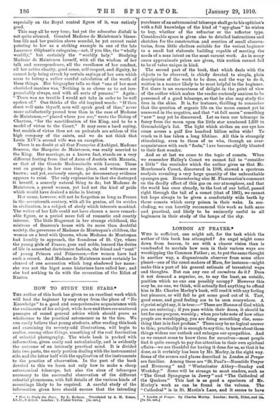HOW TO STUDY THE STARS.*
THE author of this book has given us an excellent work which will lead the beginner by easy steps from the place of "No Knowledge" to a good and comprehensive acquaintance with the rudiments of his subject, while here and there are scattered passages of sound general advice which should prove as wholesome to the practical astronomer as to the tiro. We can easily believe that young students, after reading this book and examining its seventy-odd illustrations, will begin to realise, among other things, something of the real fascination of celestial photography. The whole book is packed with , information, given easily and untcchnically, and is evidently the outcome of an intensely practical mind. It is divided into two parts, the early portion dealing with the instrumental side, and the latter half with the application of the instruments to the practice of observation. In the part of the book devoted to this we learn not only how to make a cheap astronomical telescope, but also the sizes of telescopes necessary to the successful observation of the different celestial phenomena, with full details of the various kinds of mountings likely to be required. A careful study of the information given here should ensure that the intending
• How to Study the Stars. By L. Hudson. Translated by A. H. Keane, LL.D., F.E.G.S. London : T. Fisher Unwin. [5s. net.]
purchaser of an astronomical telescope shall go to his optician's with a full knowledge of the kind of " spy-glass " he wishes to buy, whether of the refractor or the reflector type. Considerable space is given also to detailed instructions and sketches for the construction and erection of small observa- tories, from little shelters suitable for the veriest beginner to a small but elaborate building capable of meeting the needs of a man intent on the most earnest work. As in many eases approximate prices are given, this section cannot fail to be of value unique in kind.
The second part of the book, that which deals with the objects to be observed, is chiefly devoted to simple, plain descriptions of the work to be done, and the way to do it, written in a manner likely to be most helpful to the beginner. Yet there is an earnestness of delight in the point of view of the author which makes the reader curiously anxious to be possessed of a good telescope, so that he also may study the fires in the skies. It is, for instance, thrilling to remember that the question of organic life on the moon cannot yet be answered in the negative, and that "at full moon" something " new " may yet be discovered. Let us turn our telescope in fancy from the moon upon the little star numbered 1,830 in Groombridge's list. The light which strikes on our eye has come across a gulf five hundred billion miles wide! To reach us it has taken a long lifetime. All this is strangely stimulating, even to those of us who, through an over- acquaintance with such "facts," lave become slightly blunted to their first wonder.
And so at last we come to the topic of comets. When we remember Halley's Comet we cannot fail to "consider a little" the reminder which the author gives us that Mr. Moorhouse's Comet, discovered in 1908, showed a spectrum analysis revealing a very large quantity of the unbreathable oyanogen gas. Remembering also M. Flammaxion's comment on the deadly effect of this gas on our atmosphere, and that the world has once already, to the best of our belief, passed right through the tail of a comet (that of 1861), we cannot but hope always to be given a comfortably wide berth by those comets which carry poison in their wake. In con- cluding, we can heartily recommend this work as both sane and practical, and likely to be eminently useful to all beginners in their study of the lamps of the sky.






















































 Previous page
Previous page